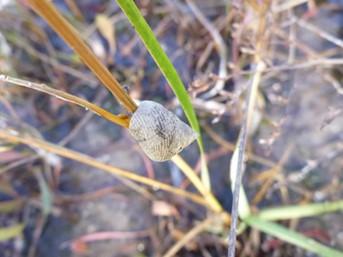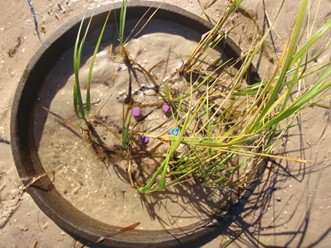 When you look across a salt marsh on Florida’s northeast gulf coast, smooth cordgrass dominates the landscape. To most of us, the grass all looks the same, but in fact, this habitat is teeming with variety. No one knows this better than visiting graduate student, Robyn Zerebecki. Robyn’s research focuses on variations in the marsh and she’s recently returned to FSU’s Coastal & Marine Laboratory to continue her graduate research under her advisor, Greg Crutsinger at the University of British Columbia.
When you look across a salt marsh on Florida’s northeast gulf coast, smooth cordgrass dominates the landscape. To most of us, the grass all looks the same, but in fact, this habitat is teeming with variety. No one knows this better than visiting graduate student, Robyn Zerebecki. Robyn’s research focuses on variations in the marsh and she’s recently returned to FSU’s Coastal & Marine Laboratory to continue her graduate research under her advisor, Greg Crutsinger at the University of British Columbia.

Robyn recently published an article with Dr. Randall Hughes, assistant professor at Northeastern University, on Littoraria irrorata’s (marsh periwinkle) presence during the reproductive period of smooth cordgrass (Spartina alterniflora), (citation: Zerebecki RA, Hughes AR (2013) Snail behavioral preference for flowering stems does not impact Spartina alterniflora reproduction. Mar Ecol Prog Ser 487:41-54).
Robyn’s work now focuses on studying the vegetative form of the plants. Vegetative stems spread their genetic information by sending out underground rhizomes, or roots, which sprout new, genetically identical plants. She is studying salt marsh community dynamics to determine how genetic characteristics in the dominant marsh cordgrass affects interactions between and within tropic levels. She is also examining if top-down and bottom-up processes maintain genetic characteristics in Spartina and if so, how this occurs. “We know that competition and predation are major biotic interactions that influence cordgrass.” Juncus (needlerush) competes with smooth cordgrass in salt marsh plant communities and the marsh periwinkle climbs cordgrass and needlerush to evade its predators. While the snails do not feed on the cordgrass directly, they cause the plant considerable damage. They puncture the blades of grass with their radula, consuming fungus that then grows on the scar. Previous experiments have demonstrated that when needlerush is present, the periwinkle spends less time on cordgrass.

In order to examine these theories more closely, Robyn’s first experiment is assessing Spartina genotype by environment interactions. This involves examining the variation in the productivity of different genotypes(or clones) when grown in the presence of a competitor plant (Juncus) and a consumer marsh periwinkle (Littoraria). Secondly, she studies how clonal trait variability (i.e. height evenness) affects the interactions between plant productivity and these biotic stressors.

Her second experiment is looking at if variations within Spartina can be maintained under various abiotic stresses. It is focused on nutrient addition and tidal height/marsh position.
Robyn’s experiments conclude in December and we can’t wait to see the results.

